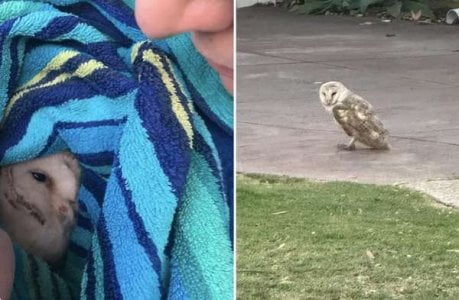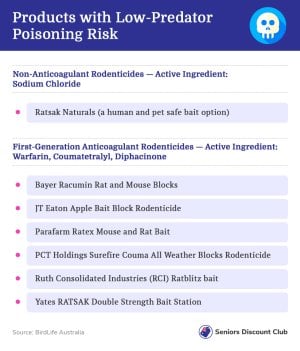Woman's rescue of distressed owl reveals ‘painful and horrific’ wildlife threat
By
Seia Ibanez
- Replies 2
In a world where wildlife thrives, our actions can either nurture or harm.
In a quiet suburb of Perth, a disturbing scene has brought to light a grave environmental issue affecting Australia's native wildlife.
This encounter serves as a stark reminder of the balance we must uphold to safeguard these creatures.
Michelle Silvestro, a resident, was out for an evening walk with her dogs in Morley when she stumbled upon a sight that would leave any animal lover heartbroken—an eastern barn owl in distress.
‘No owl would be there unless something was wrong,’ she said.
‘I asked a lady who lived there for a towel, and at that moment, eight magpies were swooping in on it, so I snuck up and put the towel on it and walked home.’

Silvestro, recognising that the owl's presence on the ground was a sign of trouble, acted quickly.
She wrapped the bird in a towel and rushed it to the nearest vet.
‘She [the vet] came back saying, "Unfortunately, it is dying,"’ she recalled.
‘She said it had a red belly and blood around the mouth, which is likely rat poisoning, and that there were a lot coming in lately [like that].’
The vet's report was a familiar one, and the owl's plight was not an isolated incident.
It's part of a worrying trend that has seen an increase in native owls and other nocturnal animals suffering and dying from rodenticide poisoning.
Wildlife shelters and veterinarians in the area are raising the alarm, urging the community to reconsider their pest control methods.
The Darling Range Wildlife Shelter WA has been vocal about the issue on social media.
In April alone, they admitted eight Aussie boobook owls, most of which showed signs of rodenticide poisoning.
The shelter's plea to the public is clear: Stop using second-generation rat baits, which are lethal not only to rodents but also to the predators that feed on them.
‘It may be peace of mind for you to just throw some cheap bulk poison into your roof, but these second-generation poisons bioaccumulate,’ Darling Range Wildlife wrote online.
‘That means the predators who eat them (via poisoned rodents) accumulate the poisons in their bodies. And the predators die too, a slow... painful... horrific death.’
Similarly, in 2022, Victorian Greens have already advocated for a state-wide ban on selling second-generation rodent poisons as part of the Agriculture Legislation Amendment Act of 2022.
Research from Deakin University has underscored the severity of the problem, revealing that a staggering 92 per cent of tested nocturnal animals, including various owl species and Tawny Frogmouths, had rat bait poison in their systems.
The study highlighted the toxic and often lethal concentrations of SGARs ‘in the liver were such that toxic or lethal impacts were likely to have occurred in 33 per cent of powerful owls we tested, 68 per cent of tawny frogmouths, 42 per cent of southern boobooks and 80 per cent of barn owls'.
The message from wildlife experts is clear: poisons should be the last resort in rodent control.

BirdLife Australia advocates for safer alternatives, such as non-toxic traps, lures, and rodent-proofing materials like wire mesh.
If baits must be used, they recommend choosing products with active ingredients like sodium chloride, warfarin, coumatetralyl, or diphacinone, which pose a lower risk of secondary poisoning to predators.
‘Purchase baits that come in block form and deliver them in tamper-proof bait stations. Tamper-proof bait stations are available at all major suppliers,’ the group said on its website.
‘Avoid bait pellets or paste as these can be easily eaten by other animals.’

Have you encountered similar wildlife issues in your area? What steps have you taken to ensure the safety of our native animals? Share your experiences and thoughts with us in the comments below.
In a quiet suburb of Perth, a disturbing scene has brought to light a grave environmental issue affecting Australia's native wildlife.
This encounter serves as a stark reminder of the balance we must uphold to safeguard these creatures.
Michelle Silvestro, a resident, was out for an evening walk with her dogs in Morley when she stumbled upon a sight that would leave any animal lover heartbroken—an eastern barn owl in distress.
‘No owl would be there unless something was wrong,’ she said.
‘I asked a lady who lived there for a towel, and at that moment, eight magpies were swooping in on it, so I snuck up and put the towel on it and walked home.’

Michelle tucked the barn owl and saved it from being attacked by magpies. Credit: Michelle Silvestro
Silvestro, recognising that the owl's presence on the ground was a sign of trouble, acted quickly.
She wrapped the bird in a towel and rushed it to the nearest vet.
‘She [the vet] came back saying, "Unfortunately, it is dying,"’ she recalled.
‘She said it had a red belly and blood around the mouth, which is likely rat poisoning, and that there were a lot coming in lately [like that].’
The vet's report was a familiar one, and the owl's plight was not an isolated incident.
It's part of a worrying trend that has seen an increase in native owls and other nocturnal animals suffering and dying from rodenticide poisoning.
Wildlife shelters and veterinarians in the area are raising the alarm, urging the community to reconsider their pest control methods.
The Darling Range Wildlife Shelter WA has been vocal about the issue on social media.
In April alone, they admitted eight Aussie boobook owls, most of which showed signs of rodenticide poisoning.
The shelter's plea to the public is clear: Stop using second-generation rat baits, which are lethal not only to rodents but also to the predators that feed on them.
‘It may be peace of mind for you to just throw some cheap bulk poison into your roof, but these second-generation poisons bioaccumulate,’ Darling Range Wildlife wrote online.
‘That means the predators who eat them (via poisoned rodents) accumulate the poisons in their bodies. And the predators die too, a slow... painful... horrific death.’
Similarly, in 2022, Victorian Greens have already advocated for a state-wide ban on selling second-generation rodent poisons as part of the Agriculture Legislation Amendment Act of 2022.
Research from Deakin University has underscored the severity of the problem, revealing that a staggering 92 per cent of tested nocturnal animals, including various owl species and Tawny Frogmouths, had rat bait poison in their systems.
The study highlighted the toxic and often lethal concentrations of SGARs ‘in the liver were such that toxic or lethal impacts were likely to have occurred in 33 per cent of powerful owls we tested, 68 per cent of tawny frogmouths, 42 per cent of southern boobooks and 80 per cent of barn owls'.
The message from wildlife experts is clear: poisons should be the last resort in rodent control.

BirdLife Australia advocates for safer alternatives, such as non-toxic traps, lures, and rodent-proofing materials like wire mesh.
If baits must be used, they recommend choosing products with active ingredients like sodium chloride, warfarin, coumatetralyl, or diphacinone, which pose a lower risk of secondary poisoning to predators.
‘Purchase baits that come in block form and deliver them in tamper-proof bait stations. Tamper-proof bait stations are available at all major suppliers,’ the group said on its website.
‘Avoid bait pellets or paste as these can be easily eaten by other animals.’
Key Takeaways
- A woman discovered an eastern barn owl being attacked by magpies, indicative of the bird's distress and potential poisoning.
- Vets and wildlife shelters in Perth were overwhelmed with native owls exhibiting symptoms of rodenticide poisoning, with urgent pleas for residents to stop using second-generation rat baits.
- Darling Range Wildlife Shelter WA has treated numerous owls for rat bait poisoning, highlighting the lethal impact of these substances on both rodents and predatory animals.
- BirdLife Australia recommends using safer rodent control alternatives like non-toxic traps or first-generation anticoagulant rodenticides and advises against second-generation anticoagulant rodenticides (SGARs).
Last edited:







